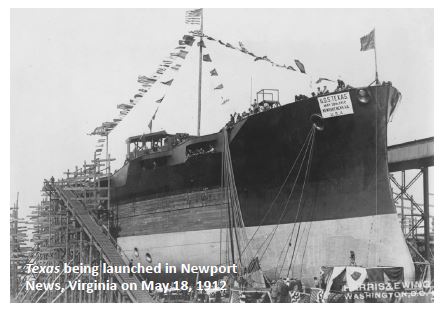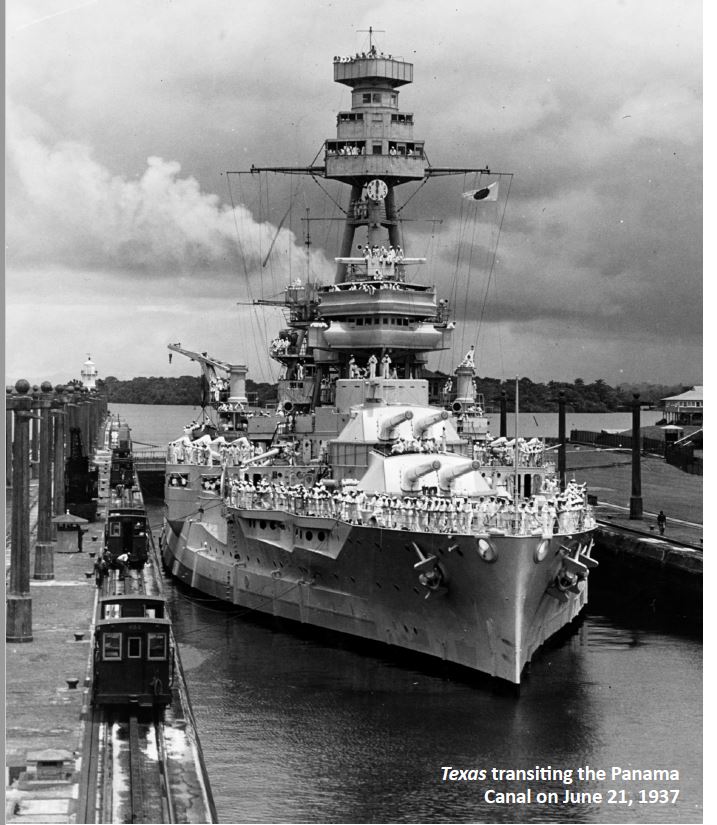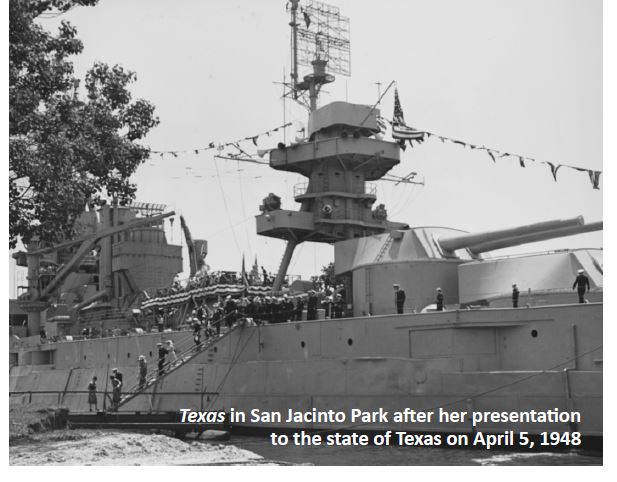 It isn’t necessary to have a military background or a knack for world history to understand why the Battleship Texas is such an historical treasure for our state and country, but her full importance is not common knowledge.
It isn’t necessary to have a military background or a knack for world history to understand why the Battleship Texas is such an historical treasure for our state and country, but her full importance is not common knowledge.
Countless school children and families have visited the Dreadnought-era battleship and San Jacinto Monument before eating at the San Jacinto Inn, and, in later years, the Monument Inn over the last few decades. The experience became a sort of rite of passage for Texans, though few questioned why the ship was located at the site of a much earlier battle.
Originally called the USS Texas (BB-35), the battleship is more than 100 years old, the last remaining U.S. battleship to see action in both world wars, and the first to be named a United States National Historical Landmark.
Construction of the USS Texas began in April 1911, by the Newport News (Virginia) Shipbuilding and Drydock Company. She launched on May 18, 1912, just one month after the sinking of the grand ocean liner Titanic.
When the USS Texas (Battleship Number 35, later designated BB-35) was commissioned on March 12, 1914, with a crew of 1,052, she was considered the most powerful ship on the seas. Her five turrets boasted twin fourteen-inch cannons capable of lobbing 1,400-pound shells over 13 miles, and twenty-one five-inch secondary guns.
Two months later, the Texas was sent to Vera Cruz, Mexico, where she aided the U.S. occupation of the city by landing 800 seamen and Marines to protect U. S. citizens and property during political unrest following the Tampico Incident.
After leaving Mexico, the Texas resumed regular operations with the Atlantic Fleet. While the battleship was on merchant patrol duty in April of 1917, the merchant ship Mongolia spotted a German U-boat preparing to strike.
The Texas averted an attack on the Mongolia by opening fire on the U-boat. These rounds were America's first formal shots of World War I.
The highlight of her service during WWI was escorting the German fleet in its surrender sailing to the Firth of Forth with the Grand Fleet of the Royal Navy.
 In March 1919, USS Texas launched the first airplane ever flown from a U.S. battleship while at anchor in Guantanamo Bay, Cuba. The plane, a British Sopwith Camel, took flight from a temporary platform that had been fitted atop her “B” turret.
In March 1919, USS Texas launched the first airplane ever flown from a U.S. battleship while at anchor in Guantanamo Bay, Cuba. The plane, a British Sopwith Camel, took flight from a temporary platform that had been fitted atop her “B” turret.
In the 1920s, tripod masts replaced the Texas’ cage mast, anti-torpedo bulges were added along her flanks, and other improvements were made to her combat systems. She was the first U.S. battleship to mount anti-aircraft guns and the first to control gunfire with directors and range-keepers.
She was recommissioned on September 1, 1927, and become the flagship of the commander-in-chief of the United States fleet. In 1928, the Texas carried President Herbert Hoover to the Pan-American Conference in Havana, Cuba.
The ship served as the flagship of the Atlantic Training Squadron, until World War II broke out in Europe. At that time, she became the Atlantic Fleet Flagship of Admiral Ernest J. King, who later commanded all U.S. naval forces during the war.
 She escorted neutral shipping within 300 miles of the U. S. shores until, on June 20, 1941, she narrowly missed becoming the first U. S. Navy loss of the war when she outran the attack maneuvers of the German submarine U-203. She was stationed in Casco Bay, Maine, on the day the Japanese attacked Pearl Harbor.
She escorted neutral shipping within 300 miles of the U. S. shores until, on June 20, 1941, she narrowly missed becoming the first U. S. Navy loss of the war when she outran the attack maneuvers of the German submarine U-203. She was stationed in Casco Bay, Maine, on the day the Japanese attacked Pearl Harbor.
The warship took part in her first combat operations of the Second World War in support of Operation Torch, the Allied invasion of North Africa. During the operation, the Texas transmitted Lieutenant General Dwight D. Eisenhower’s first “Voice of Freedom” broadcast.
As a young news reporter, Walter Cronkite was among those onboard the battleship during the operations and was granted permission to fly off of the ship in one of her OS2U Kingfisher aircraft.
During the Battle of Cherbourg of the D-Day invasion in June 1944, USS Texas was hit several times. A German 11-inch shell exploded on the bridge killing the helmsman, Quartermaster 3rd Class Christen Christensen (the only casualty ever to take place aboard the battleship), and wounded 13 others on the navigation bridge.
Another armor-piercing 9-inch shell penetrated the ship's armor directly above the wardroom. The shell was a dud and did not explode. After the battle, the navy safely defused the shell and returned it to the Texas as a good luck charm, where it has remained ever since.
Following repairs, the Texas supported Allied landings in southern France, provided fire support for the invasion of the island of Iwo Jima, and supported the war’s largest amphibious operation—the invasion of Okinawa.
After the Japanese surrender in August 1945, the ship made three “magic carpet” runs from the Pacific to the States, ferrying home more than 4,000 American soldiers.
The Texas earned a total of five battle stars for her service in the Second World War. After 34 years of service, the Battleship Texas was decommissioned and turned over to her namesake state, where she was recommissioned on April 21, 1948, as the flagship of the Texas Navy. She has been maintained as a memorial at the San Jacinto Battleground since that time, permanently moored as a museum ship.
The illustrious ship, now designated a U.S. National Historic Landmark, has continued to fight, but her battle is now against relentless deterioration. After a move to Gulf Copper’s new dry dock in Galveston, $35 million worth of repairs will take place to restore her. Galveston is one of a number of Texas cities vying to become her new home after the work is complete.
 A few things you might not know about the USS Texas:
A few things you might not know about the USS Texas:
1. She’s the same age as the Titanic.
2. She fired the first American shots of World War I.
3. She was the first ship to use centralized remote control fire directors.
4. She was the first ship armed with anti-aircraft guns.
5. A German shell that struck the ship is still on board.
6. She is the only remaining U.S. battleship to have participated in both World Wars.
7. She is the last surviving World War I-era Dreadnought.
8. She was the first U.S. battleship to become a museum.